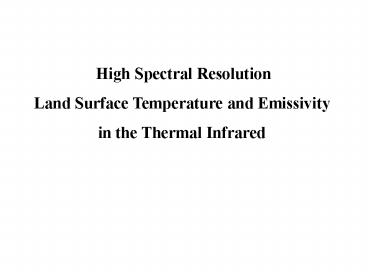High Spectral Resolution Land Surface Emissivity and Temperature
1 / 23
Title:
High Spectral Resolution Land Surface Emissivity and Temperature
Description:
PLAYA CHARACTERIZATION 3. - LAKE RODGERS ... PLAYA CHARACTERIZATION 6. - DECORRELATION STRETCH. Source: Gillespie et al, 1986. PC2 ... –
Number of Views:59
Avg rating:3.0/5.0
Title: High Spectral Resolution Land Surface Emissivity and Temperature
1
High Spectral Resolution Land Surface
Temperature and Emissivity in the Thermal Infrared
2
INTRODUCTION 1.
- Technique for ground-based validation of land
surface emissivity/temperature with atmospheric
sounding. - Implements new class of algorithm on workable
scale for later extension to space-borne (AIRS,
IASI, CrIS) application. - Emissivity measurement linked with other
fields, eg geology and land use (ASTER, MODIS).
3
INTRODUCTION 2.
Surface Temperature
TIR emission from land surface
Composition
Emissivity
Texture
View Angle
Derived from single spectral measurement N
measurements N1 unknowns
4
INTRODUCTION 3.
- Temperature/emissivity separation problem in
past solved assuming surface characteristic. - Surface emission is spectrally smoother than
atmospheric - extra constraint needed. - Resolved atmospheric lines are used rather than
discarded.
5
ALGORITHM 1.
RTE for downlooking sensor
Make assumptions 1. Neglect sub-sensor
atmosphere 2. BRDF constant f ?? 3.
Kirchhoff ? 1 - ?
6
ALGORITHM 2.
Final working equation
Downwelling emission characterized by
Optimum quadrature - 50 to 60 degrees from zenith
7
ALGORITHM 3.
Example AERI upwelling and downwelling spectra
8
ALGORITHM 4.
Optimum skin temperature at minimal atmospheric
lines shown in middle trace below.
9
ALGORITHM 5.
Implemented by determining surface temperature at
minimum mean squared derivative of a spectral
window
10
ASPHALT SURFACE 1.
45, 60 70 surface measurement of
quasi-diffuse asphalt parking lot with uniform
temperature. Quartz!
Christensen Frequency
Reststrahlen
11
ASPHALT SURFACE 2.
Sensitivity of derived emissivity to choice of
sky view angle. 60 degree surface view used with
T 293.5K.
12
DIURNAL MEASUREMENTS 1.
Measurements taken over pre-sunrise to
mid-morning period of heating. Variation in
derived skin temperature
13
DIURNAL MEASUREMENTS 2.
Average emissivities 1 standard deviation
during this period of morning heating (total
measurements 14). Shows no moisture and good
repeatability to 1.
14
PLAYA CHARACTERIZATION 1. - LAKE RODGERS
At least 2 surface types visible on Lake Rodgers
however
Darker
Lighter
15
PLAYA CHARACTERIZATION 2. - IVANPAH PLAYA
A similar playa reveals possible source for the 2
distinct signatures - weathering.
16
PLAYA CHARACTERIZATION 3. - LAKE RODGERS
Back to Lake Rodgers - AERI shows signatures of 2
differently colored surfaces also different in
TIR. Go to MAS for spatial
17
PLAYA CHARACTERIZATION 4. - LAKE RODGERS
MAS Visible RGB Composite Bands 3/2/1 Shows
visible differences on the playa surface.
18
PLAYA CHARACTERIZATION 5. - LAKE RODGERS
MAS TIR Bands 42 - 43 Highlights the
brown-colored surface with feature at 1040 cm-1.
19
PLAYA CHARACTERIZATION 6. - DECORRELATION STRETCH
Inv. Transform
Band A
Source Gillespie et al, 1986
20
PLAYA CHARACTERIZATION 7. - LAKE RODGERS
MAS TIR Decorr. Stretch Bands 42/43/46
Silicate
Brown surface previously identified
21
LAND USE CHARACTERIZATION 1. - SUCCESS (OKLAHOMA)
Further combined use of AERI and MAS for
identifying land use in Oklahoma.
22
LAND USE CHARACTERIZATION 2. - SUCCESS (OKLAHOMA)
MAS TIR Bands 42 - 45 Red Vegetation Green Bar
e Soil Blue Strong Silicate (Near River)
23
MISCELLANEOUS SURFACES































